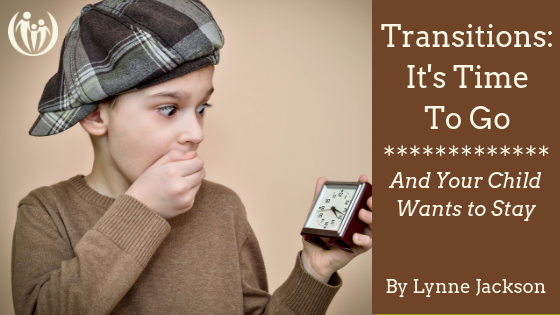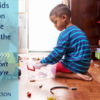
Transitions: It’s Time to Go
Does this sound familiar? Picture yourself standing, hands on hips at the front door saying (maybe loudly, even): “C’mon, kids. It’s time to go. Kids…. Kids…. It’s time to go!!! You need to listen to me! Get moving – NOW!” Does this pattern repeat itself every time your kids need to make a transition?
It can be tough for some kids to simply come to a meal or come in from playing outside, let alone get organized to get into the car. The busier your schedule, the more times you have to get your kids away from what they are doing and on to the next thing. Since these transitions become the “bookends” of each activity in your day, they tend to create repeated patterns of either teamwork or power struggles.
Something to Consider About Transitions
To avoid the power struggles and nurture teamwork, it helps to consider – What’s my long-term goal with this challenge? Am I purely focused on my own convenience, or do I really want to help my kids learn the flexibility and responsibility that will serve them well in various changes/transitions in life?
Before you try to start addressing the ultimate goal of teaching responsibility it is important to remember to focus on communicating the first of the four Discipline That Connects messages: “You are SAFE with me.” What’s going on in me that affects how I engage with my child during transitions?
How a parent prepares for transitions makes a huge difference as to how their child responds:
1) Prepare ahead. Change = stress for an immature brain, and stress shuts down your child’s frontal lobe (the part that handles rational thinking), so make sure you don’t share your anxiety and stress by your own procrastination! Set a timer to remind you to get ready first before engaging the kids, announcing loudly that you are getting ready to go. You will then be modeling responsibility and you’ll be much more equipped to approach them peacefully.
2) Walk in their shoes. Wise engagement starts with insight into our kids’ experience. Consider: How would I feel if a cranky, stressed person told me numerous times per day that I had to leave on their timetable… just when I was engrossed in a favorite book or thoroughly enjoying coffee and a deep conversation with a friend? What would be my attitude and response?
3) Nag-proof your thinking. If you subtly believe, “It is my job to herd all you little rascals to the car,” your child will likely believe, “It’s my job to artfully dodge being herded,” and it will be game on. So recognize your kids are capable and responsible!
Note: Consider whether you’re telling or asking your kids, and which might be better.
My Response:
- What’s my number on this 0 to 10 scale:
0 = I don’t care about my kids’ current activities, I just want them to MOVE toward the car!
10 = I really get how difficult it is for them to leave their favorite activities. - How might my attitude about leaving be influencing how it often goes?
- What helpful thought or perspective could help me approach these transitions with a peaceful, understanding heart?
The above selection is the first part of the Transitions/Leaving section of the Appendix to Discipline That Connects With Your Child’s Heart. Order HERE for practical strategies to help kids know they are loved during this challenge, but also capable and responsible for getting themselves ready to leave. Transform the daily exasperation of transitions with practical tools to ease the stress and build connection and cooperation.
Here is a full list of Appendix topics from Discipline That Connects With Your Child’s Heart:
Appendix A: Self-motivated, Responsible Kids
- Messes
- Chores
- Not Listening
- Homework and grades
- Screen time
Appendix B: Peaceful Daily Routines
- Mornings
- Meals
- Transitions/leaving
- Bedtime
Appendix C: Growing True Respect and Reconciliation
- Whining
- Tantrums/Meltdowns
- Defiance
- Lying
- Disrespect/Sass
- Sibling Conflict and Aggression
Sign up below to receive a weekly dose of encouragement straight to your inbox:






